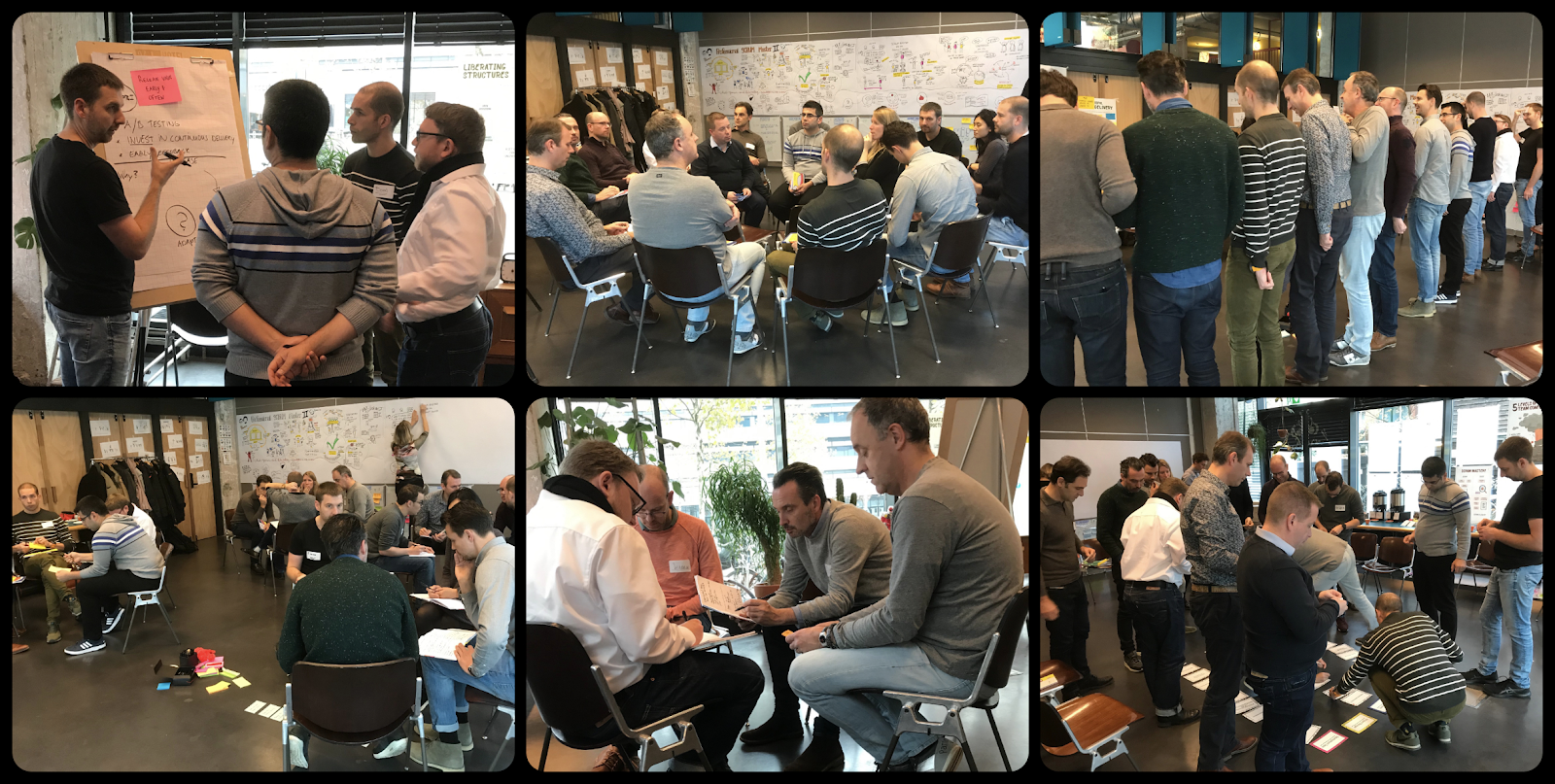In August 2018, Scrum.org launched the Professional Scrum Master II class. The intention of this class is to offer the Scrum community an advanced class designed to support Scrum Masters in their professional development. A characteristic of the PSM II class is that it contains lots of Liberating Structures.
Therefore the question that emerges is…
“What is the value of Liberating Structures for Scrum Masters?”
What are Liberating Structures?
Liberating Structures are a collection of 30+ interaction patterns that unflatten, enrich and deepen interactions in groups. With strong roots in complexity science, and collected by Keith McCandless and Henri Lipmanowicz, all Liberating Structures implement five design elements and ten principles. This means that Liberating Structures are not a rigid, static set of formats. New structures are being developed all the time and existing structures are modified, adjusted or removed. With Liberating Structures, it’s possible to start shifting entire organizations by tweaking the way groups and individuals interact.
Although this might sound fluffy and vague, this article will provide five tangible examples of how they are tremendously valuable for Scrum Masters.
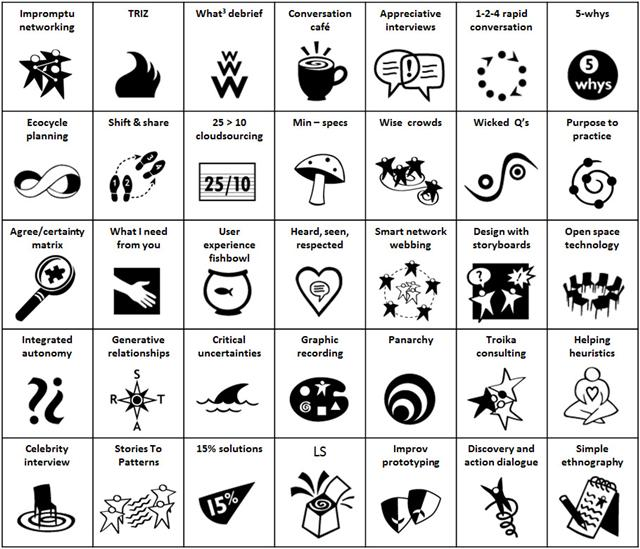
The 30+ Liberating Structures
1. Liberating Structures allow Scrum Masters to fulfill their role according to the preferred stances
Being an effective and successful Scrum Master requires a wide variety of skills, knowledge, and experience. This variety is captured in the stances of a Scrum Master. The Scrum Master is expected to act as a teacher, impediment remover, facilitator, coach, mentor and change agent. Everything, with servant-leadership as the foundational mindset and attitude. Liberating Structures enable the Scrum Master to fulfill their role according to these stances. For each stance, I’ll provide some examples that a Scrum Master can use. For more detail, check the underlying articles.
- Teacher: Shift & Share, Celebrity Interview, Spiral Journal
- Impediment Remover: Troika Consulting, TRIZ, 15% Solutions
- Facilitator: Open Space Technology, Conversation Cafe, 25/10 Crowd Sourcing
- Coach: Heard — Seen — Respected, Helping Heuristics, Wise Crowds
- Mentor: UX fishbowl, Future ~ Present
- Change agent: What I Need From You, Ecocycle Planning, Critical Uncertainties
Another advantage is that by using these Liberating Structures, you prevent fulfilling the role according to the misunderstood stances of a Scrum Master: being the Scrum Police, Hero, Scribe, Secretary, Coffee Clerk, Chairman, Admin or the Team Boss. Give it a try, and see if you also notice how Liberating Structures almost automatically helps you fulfill your Scrum Master role according to the preferred stances!
A variety of Liberating Structures is being used in the Scrum.org PSM II class that encourages Scrum Master to reflect on their role.
2. Liberating Structures support Scrum Masters in being a servant leader
The Scrum Master fulfills all the stances of a Scrum Master by having the mindset and attitude of a servant-leader. As a Scrum Master, you are always a servant-leader, regardless of the stances you take. A Scrum Master can show servant-leadership by…
- Restraining from solving and instead ask questions which encourages the team members to figure out their own solutions;
- Showing vulnerability by being open about problems, personal issues or anxiety, this lowers the barrier for others as to be open as well;
- Creating a safe environment, where constructive disagreement is encouraged and team conflict is considered as an opportunity for growth and improvement.
According to Robert Greenleaf, the best test of servant-leadership is to ask yourself: do those served, grow as persons? Liberating Structures are a perfect fit to pass this test. They ensure that all voices are included and represented and allow everyone in a group to be unleashed and involved — from extroverted to introverted and from leaders to followers. Each person has the opportunity to share his/her opinion and suggest ideas for improvement. This equal distribution of participation also helps remove any hierarchy that might exist in the team or organization. All of this unlocks individual superpowers and thus helps pass the test of servant-leadership!
“Liberating Structures ensures that all voices are included and represented.”
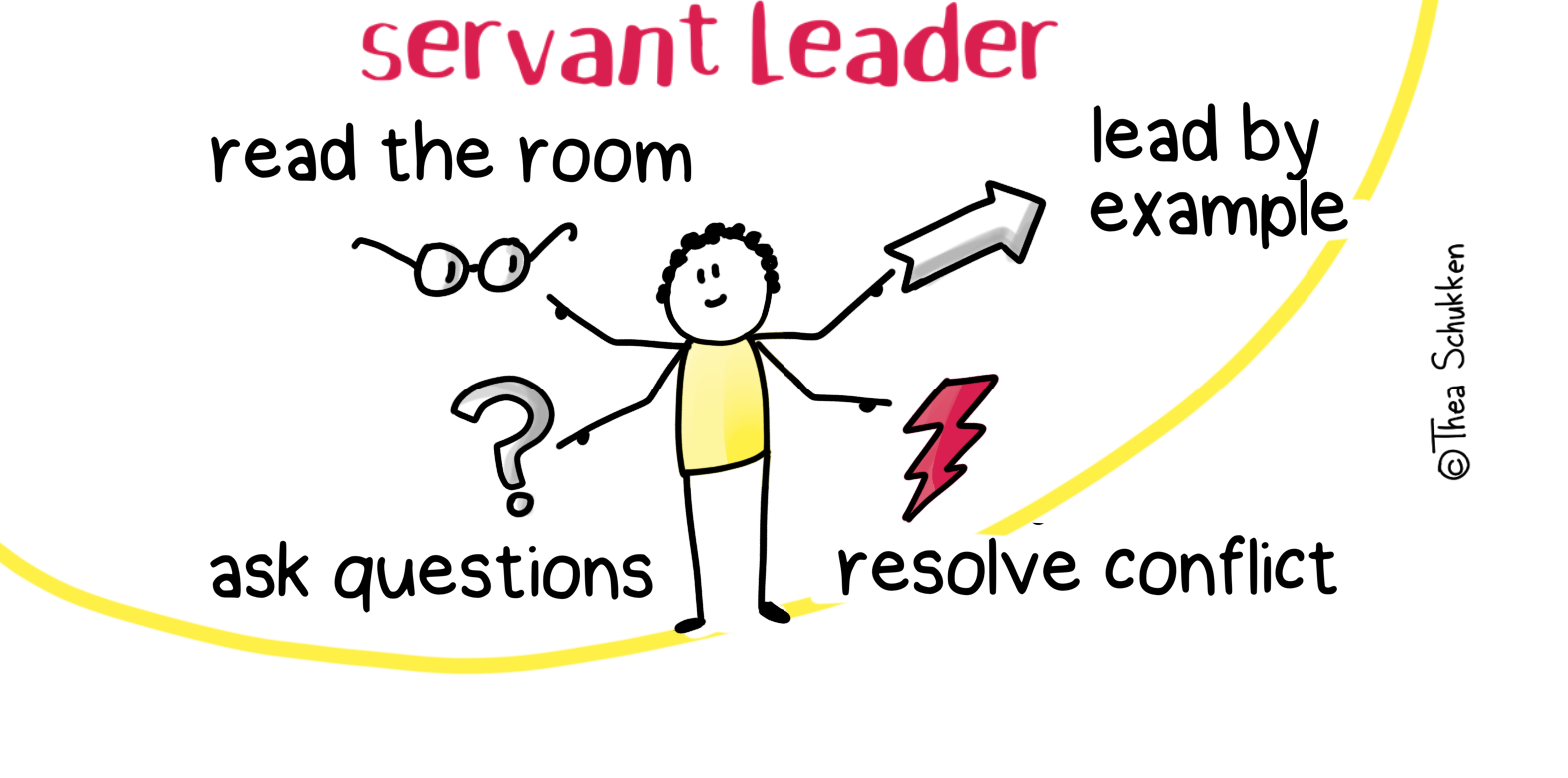
The Scrum Master as a Servant-Leader
3. Liberating Structures provide boundaries for self-organization
One of the responsibilities of a Scrum Master is to coach the Development Team in self-organization. In the complex domain, best practices don’t work. Therefore, it’s up to the Development Team to determine the best way to accomplish its work and build ‘Done’ Increments. Figuring this out requires self-organization. Scrum supports self-organization by offering a lightweight framework that contains only three roles, five events, and three artifacts. It’s up to the Scrum Master to manage the Scrum framework and thereby manage the boundaries of self-organization.
When focusing on the Scrum events, what happens a lot is that they become too structured and inhibiting, with one person talking while the rest ‘listens’ — like presentations, status meetings, and managed discussions. Or the Scrum events are too unstructured and loose, with only a handful of people talking while the rest is struggling to keep up — like brainstorms and open discussions. Examples of how these conventional ways of interactions often manifest in the Scrum events are…
- Presentation → Sprint Review
- Status meeting → Daily Scrum
- Managed discussion → Sprint Planning
- Brainstorm and open discussion → Sprint Retrospective
By using Liberating Structures, the Scrum Master can tap into the full wisdom, experience, and perspectives of the Scrum Team or organization to resolve impediments, make decisions, share knowledge and innovate. By doing so, it prevents the Scrum events to become unproductive presentations, status meetings, etc. Examples of Liberating Structures that help the Scrum Master coach the Development Team in self-organization are…
- Troika Consulting: give and get help on the problems team members are facing;
- Critical Uncertainties: develop strategies for the different challenges the team can get into;
- Improv Prototyping: create effective solutions to chronic challenges while having serious fun.
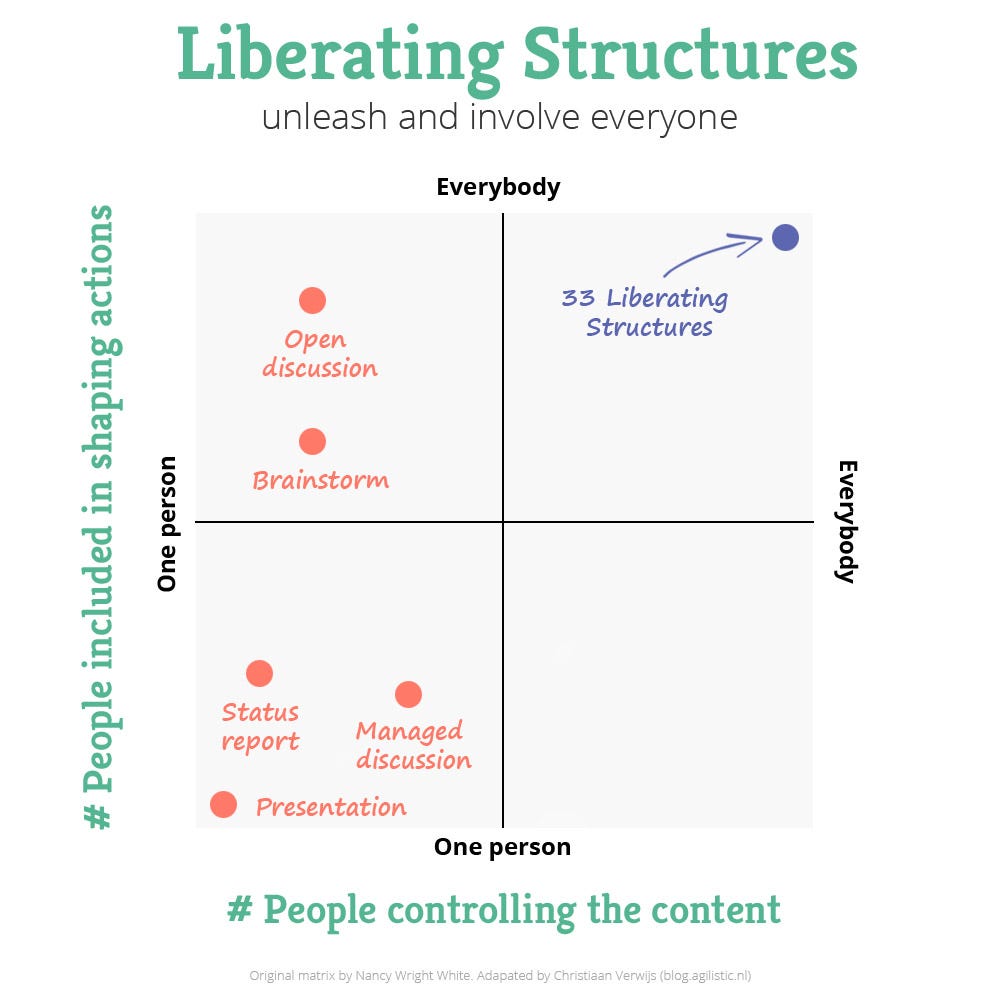
4. Liberating Structures prevents Zombie Scrum
Scrum is HUGE! It’s massively adopted by organizations. That’s of course awesome! Except for the fact that many organizations and teams think they’re doing Scrum, while they’re not.
Sure, they’ve got all the Scrum roles, events and artifacts in place. But there’s no working software at the end of the Sprint. There’s no drive to improve. There’s no emotional response to success or failure. No involvement of customers and users during development.
This might look like Scrum from the surface. But it isn’t. This is Zombie Scrum, and it needs to be stopped.
One of the main causes of Zombie Scrum is that teams often have no idea why they are even doing Scrum. When we ask teams infected with Zombie Scrum why they are doing Scrum, we often hear statements like…
- “Because our Agile Coach said this was a great idea”
- “Our CEO was promised an increase in productivity of 2000%”
- “All our competitors are using it as well”
Not knowing why you’re doing Scrum will definitely result in Zombie Scrum!
Luckily, with Liberating Structures this can be prevented and/or stopped. Some of the 30+ interaction patterns help teams define a common purpose and strategy and make working with Scrum a joint effort. Not as a one-time trick, but as a continuously recurring activity focused on using Scrum in such a way it’s tailor-made for your organization.
How? Read the paper by Keith McCandless and Johannes Schartau about Liberating Strategy. It offers 6 questions that will help define a shared purpose and strategy. To answer these questions a variety of Liberating Structures can be used, for example…
- Purpose: What is the fundamental justification and deepest need for our work? → Nine Whys
- Context: What is happening around us that demands creative change → Critical Uncertainties
- Challenge: What are the paradoxes we must face in order to make progress? → Wicked Questions
- Baseline: Where are we starting, honestly? → What, So What, Now What?
- Ambition: Given our purpose, what seems possible now? → 25/10 Crowd Sourcing
- Action and evaluation: How are we acting our way toward the future, evaluating what is possible as we go? → Ecocycle Planning
I strongly encourage you to read the paper for more detail, it will definitely help you prevent the #1 cause of Zombie Scrum!

Scrum Zombies (visual by Maarten Brugman)
5. Liberating Structures support Scrum Masters in their on-going journey
Scrum Masters are responsible for helping organisations find ways to deliver value to stakeholders faster and more frequently with Scrum. This is no simple task and requires creativity, intelligence and close collaboration with developers, product owners, and management.
Being Scrum Masters ourselves, we’ve experienced the importance of sharing learnings & insights and to have the opportunity for giving and getting help. By growing a community of Scrum Masters, inside and outside the organization, dealing with common challenges becomes a joint effort. Liberating Structures can be used as the foundational interaction patterns by which Scrum Masters support each other's journey. For example:
- Conversation Cafe: making sense of profound challenges
- Wicked Questions: define the paradoxical challenges Scrum Masters must confront to succeed
- Wise Crowds: tap the wisdom of the whole group
Eager to learn more about how this works in practice? Read this article about the Scrum Master Learning Journey and experience it yourself in this kickoff workshop. Whatever you do, we encourage you to seek out other Scrum Masters to grow together. Let’s build communities that cause change!
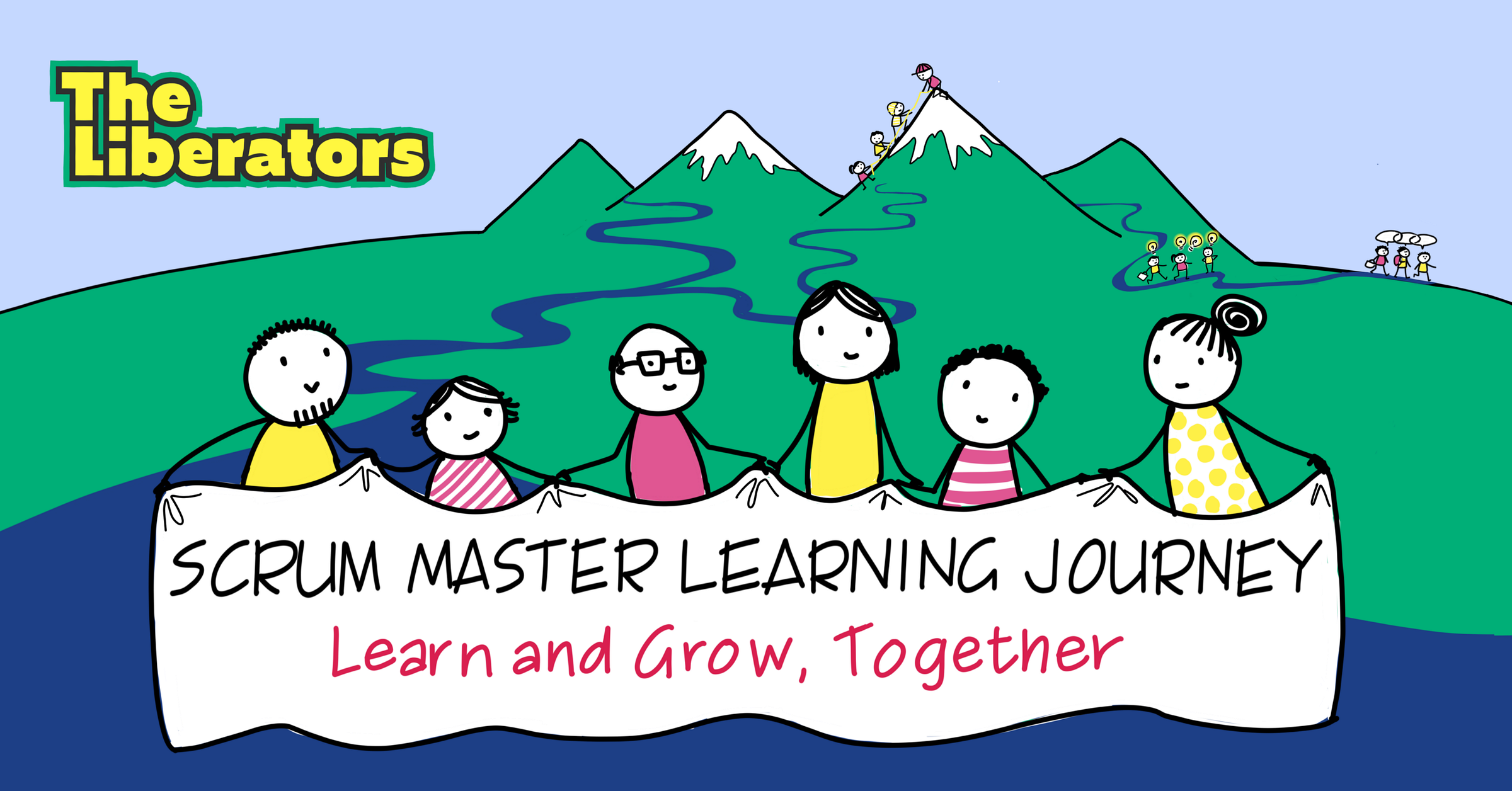
Scrum Masters, let's go on a journey together! (illustration by Thea Schukken)
Closing
This article provides five examples of how Liberating Structures are valuable for Scrum Masters. Liberating Structures allow Scrum Masters to fulfill their role according to the preferred stances, they stimulate servant-leadership, provide boundaries for self-organization, prevent Zombie Scrum and support Scrum Masters in their on-going journey.
I can imagine this article might be overwhelming. Luckily there is plenty of opportunity for some aftercare. You can join the Dutch User Group to learn more about Liberating Structures or attend one of our Immersion Workshops. Our events page is packed with workshops related to Scrum & Liberating Structures. I’m sure there’s something interesting to find for you!

See how you can support us at patreon.com/liberators

